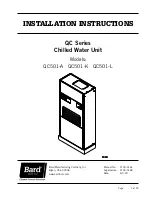
80
Repeated Low Suction Temperature Protection
Alarm 108 — Circuit A (P.40)
Alarm 109 — Circuit B (P.41)
Criteria for Trip
— The criterion is tested when the circuit is
ON. If the circuit operates and if more than 8 successive circuit
capacity decreases (stop the compressor) have occurred because
of low suction temperature protection overrides, the circuit
alarm will be tripped. If no override has occurred for more than
30 minutes, the override counter will be reset to zero.
Action to be Taken
— ALARM_LED will be set to blinking.
Alert relay will be energized.
Reset Method
— Automatic, when the override counter returns
to zero. If the alarm is cleared via the Manual method, the
counter will be forced to zero.
Possible Causes
— If this condition is encountered, check the
following items:
• suction transducer for accuracy
• suction transducer wiring
• EXV operation
• refrigerant charge (undercharged)
• evaporator loop for low water flow
• evaporator leaving water temperature
• suction service valve to be sure it is open. Discharge pres-
sure transducer for accuracy
• unit configuration
Alarm 111 — Low Entering Water Temperature in Heating
(P.43)
NOTE: Alarm 111 is not used or supported. If this condition is
encountered, confirm machine configuration.
Condenser Default
Alarm 112 — Pump 1 (P.73)
Alarm 113 — Pump 2 (P.74)
NOTE: Alarms 112 and 113 are not used or supported. If this
condition is encountered, confirm machine configuration.
High Discharge Temperature
Alarm 114 — Circuit A (P.78)
Alarm 115 — Circuit B (P.79)
Criteria for Trip
— The criterion is tested when the compressor
is operating. This alarm will be tripped if the discharge gas tem-
perature is higher than 212 F (100 C) for more than 90 seconds.
Action to be Taken
— The affected compressor will be
stopped.
Reset Method
— Manual.
Possible Causes
— If this condition is encountered, check the
following items:
• Maximum Condensing Temperature (MCT) for the proper
setting
• noncondensables in the refrigerant circuit
• refrigerant charge (overcharged)
• condenser tubes fouled
• the discharge service valve to be sure that it is open, check
the discharge pressure transducer for accuracy
• unit configuration
Low Economizer Pressure
Alarm 117 — Circuit A (P.81)
Alarm 118 — Circuit B (P.82)
Criteria for Trip
— The criterion is tested when the compres-
sor is operating to prevent pumpdown conditions when the
suction service valve is closed. This alarm will be tripped if the
economizer pressure is below the suction pressure more than
1 bar (14.5 psi) for more than 10 seconds.
Action to be Taken
— The affected compressor will be
stopped.
Reset Method
— Manual.
Possible Causes
— If this condition is encountered, check the
following items:
• suction service valve is closed
• sensor wiring to the EXV boards
• boards for faulty channels
• faulty transducer
• economizer EXV operation
Slide Valve Control Unverifiable
Alarm 120 — Circuit A (P.87)
Alarm 121 — Circuit B (P.88)
Criteria for Trip
— The criteria are tested when the compres-
sor is operating and the active cooling set point is greater than
32° F (0° C). This alarm will be tripped if:
• The circuit is operating at 100% of capacity and the mea-
sured current is less than 1.1 times the current at fully
unloaded 30% for more than one minute.
Action to be Taken
— The affected compressor will continue to
run.
Reset Method
— Manual.
Possible Causes
— If this condition is encountered, check the
following items:
• faulty unloader solenoid valves
• faulty unloader solenoid coils
• wiring of the unloader solenoid valves
• CPM board for faulty channels
• current transformer reading for accuracy
Alarm 123 — Cooler Flow Switch Setpoint Configuration
Failure (P.90)
NOTE: Alarm 123 is not used or supported. If this condition is
encountered, confirm machine configuration.
Alarm 124 — Cooler Flow Switch Failure (P.91)
Criteria for Trip
— The criteria are tested when the unit is on
or off. This alarm will be tripped when the unit is on if:
• The flow switch fails to close after the Off/On delay.
• If the master/slave control is active, the unit is the lag chiller
and if the cooler flow switch fails to close within one minute
after the cooler pump was restarted. The alarm is ignored if
the lag cooler pump is stopped as a result of master/slave
control.
• The flow switch is opened during normal operation.
The alarm will be tripped when the unit is off if:
• The cooler pump control is enabled (
Cooler Pumps
Sequence
, PUMP
=0
)
and the cooler flow switch is checked
when the pump is enabled (
Flow Checked if C Pump Off
,
P.LOC
)
and the cooler flow switch is closed after the cooler
pump is commended OFF for more than 2 minutes.
• The flow switch fails to close after the Off/On delay after
the cooler pump has been turned on to protect the cooler
from freezing (
Cooler Pumps Sequence,
PUMP
=0
).
Action to be Taken
— For criteria for trip A1 and A2, the com-
pressors will not be started.
For criteria for trip A3, all compressors will be stopped without
going through pumpdown. Cooler pump will be stopped with
no delay.
For criteria for trip B1, the unit will not start.
Reset Method
— Manual if at least one compressor is operat-
ing. Automatic if no compressors are operating.
Possible Causes
— If this condition is encountered, check the
following items:
• a faulty flow switch
• flow switch wiring
• Main Base Board for a faulty channel
Alarm 128 — Service Maintenance Alert (Sr.nn)
Criteria for Trip
— This alert is tested whether the unit is ON
or OFF and when the Servicing Alert decisions listed under
Time Clock MCFG
have been enabled. The alarm will be
















































